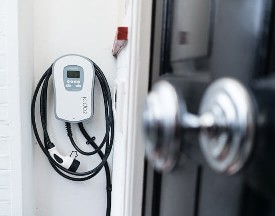
Running an Electric Car on Solar Energy
One of the most common questions we are asked is: can I run my car on solar energy?
It seems to be the logical next step for electric vehicle owners to want to power their cars in the cleanest way possible – ideally from solar electricity produced on their own roof. Replacing a petrol or diesel vehicle with an EV already removes local particulate emissions and reduces CO2 emissions by 50%. But why not go one step further and run your car with zero particulates and zero carbon impact?
As well as being green, using solar energy to power your electric car is also the cheapest way of running it. A 4kW solar PV system produces enough electricity in a year to power a BMW i3 for 20,000 miles. Over the 25-year lifetime of a solar roof, that’s 500,000 zero-carbon miles.
With solar roofs starting at around £5,000, that’s about 1p/mile.
Run your car on sunshine
There are two different approaches to running your car on solar energy, depending whether you are parked at home or if you are out at work during the day.
The National Household Travel Survey reporting that 41% of vehicles are at home during the day. By contrast 31% are at work, 17% other (e.g shopping) and 10% actually driving on the roads.

If you are at home during the day, we recommend the Zappi electric car charger. If you are at work during the day, then you’ll need to adopt a battery-to-battery approach.
Run your car on solar with the Zappi
If you own one of the 41% of vehicles that are at home during the day, then you can use your own solar electricity to fill up your car battery. This requires a specialised EV charging point such as the recently launched Zappi, from myenergi. It takes the excess solar electricity that would otherwise be exported back to the grid, and diverts it into the EV battery. That’s good news from an electric vehicle point of view – it’s now running off zero carbon electricity. But it’s also good news from a solar point of view – the generated electricity is now used by you rather than disappearing out the front door. That means you don’t have to import electricity to charge the car – which equals bill savings and much better economics on your PV system.

The Zappi operates in a similar way to devices that divert excess solar to put into hot water, which have existed for many years (indeed myenergi’s background is in this area). However, diverting solar electricity into EVs offsets dirty grid electricity, offering substantial carbon savings. Diverting solar electricity into hot water offsets (relatively) clean gas in 90% of cases. So from an environmental perspective it is better to divert excess solar into a vehicle than into hot water.
Battery-to battery systems
If you are not at home during the day, then you can still run your car on sunshine using a battery-to-battery approach. This is a technological solution that we have been pioneering, and popularised by Robert Llewellyn’s home system as featured on Fully Charged.
In this case, excess solar energy is stored in a large home battery, such as the Tesla Powerwall, and then diverted into the vehicle when it returns home. A typical daily cycle might look like this:
- The battery starts off virtually empty.
- As solar electricity is generated, it is used in the home. Any excess solar electricity is captured by the battery.
- In the evening, when the sun has gone down, the battery discharges into lights and appliances in the home. These are the high value uses for electricity.
- During the night, the EV starts to charge. The chargepoint is set to run off a timer to restrict the charging to night-time period.
- This will first empty the battery of any remaining stored solar electricity
- If the vehicle battery is not full, it will top up with cheap night-time electricity. There are EV specific tariffs available to give you these preferential night-time rates.
- The next morning the cycle repeats again.
This approach might seem a little odd at first – after all there are thermodynamic losses associated with filling a battery, then discharging it into another battery. However, this is outweighed by the benefits:
- It maximises your self-consumption of generated solar electricity, which improves the economics of solar PV array because you don’t have to import electricity from your supplier.
- Because charging the vehicle fully empties the battery, it’s then set up to capture the maximum possible solar energy the next day. By contrast, a battery starting the day partially charged wouldn’t be able to capture as much solar the next day.
- You are always filling your vehicle with the cheapest possible electricity. Your own solar electricity will be the cheapest, followed by night-time imports, and as a last resort, conventional daytime electricity. It means you cant fail to get the cheapest possible miles/kWh.
- And many of our customers report is that doing this, and knowing you are running your car in both the cheapest and greenest way, feels great!
It’s worth mentioning, that you can get the best of both worlds. The Zappi can act like a conventional EV charger as well, and is also comparatively priced. So, it is possible to run a battery-to-battery approach during the week, but use the Zappi to directly charge your vehicle at the weekends. That looks to be ideal!
Could you put solar panels on the roof of a car?
Whilst this is helpful, ultimately you won’t get enough electricity to fully power your car just from the roof of the car. Let’s run the numbers:
A typical car roof could host about 400W of solar cells. In the middle of summer, in the UK, this would produce, on average 2kWh per day. That would be about 10 miles in a BMWi3, around 6 miles in a Tesla. Not bad, but less than a typical day’s mobility, especially if you commute.
In the middle of summer, you’d only be generating just 0.4kWh/day, or 2 miles in a BMW i3. Again, it all helps, but you’ll always need some form of external charging for reliable mobility. As a rule of thumb, you’d need another order of magnitude to fully power an EV from the sun. Conveniently, an order of magnitude larger is about the size of a typical home roof!
The big picture
The grander picture is that we are seeing the solar energy, battery storage and electric vehicle sectors come together. People who own one of these technologies are now looking at the other two, whilst physical devices such as the Zappi are enabling solar energy to provide mobility, not just powering your lights and appliances.
Find Out More …
- If you’re parked at home during the day, use the Zappi EV charger to fill up your car with sunshine
- If you’re at work during the day, go battery-to-battery with the Tesla Powerwall
- That’s what we call the full set of solar PV, battery chargepoints and EV chargers



Sorry, the comment form is closed at this time.